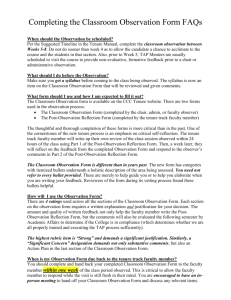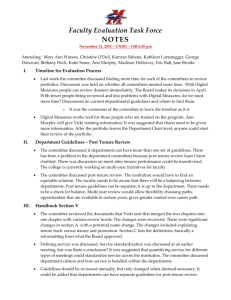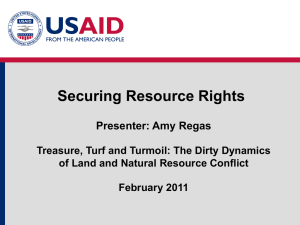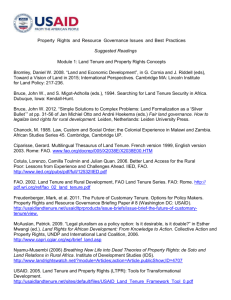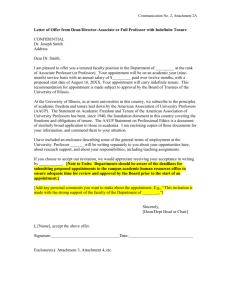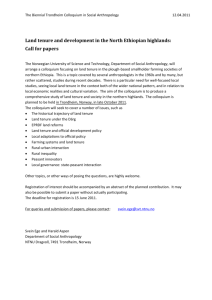PAAP Newsletter Vol 12 No. 2
advertisement
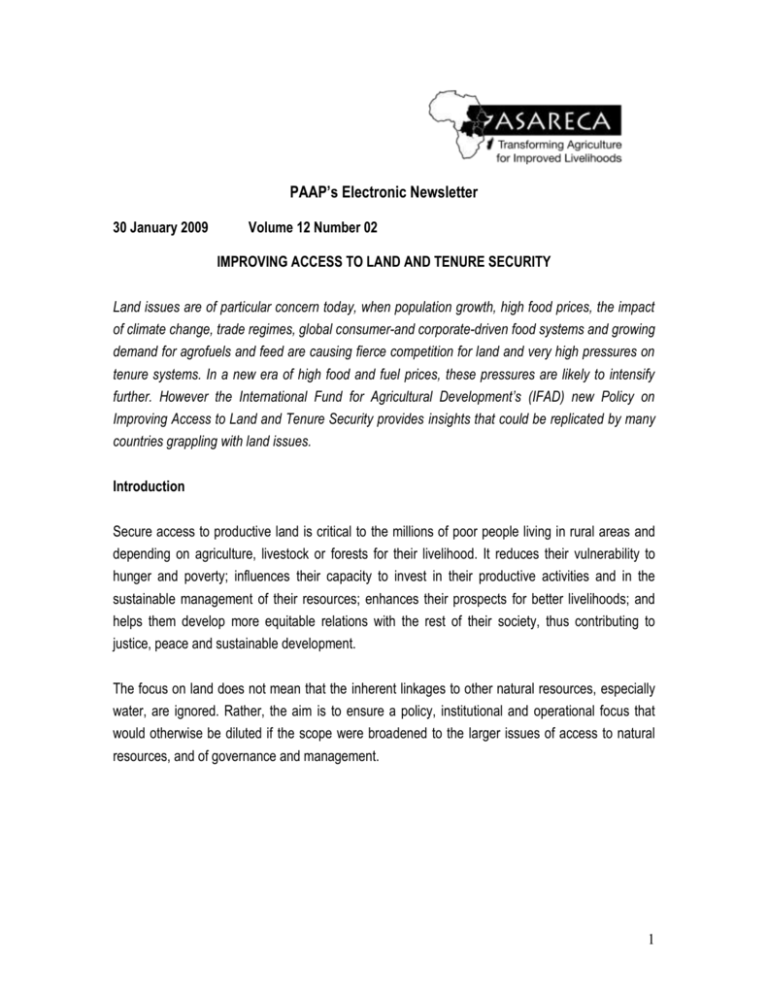
PAAP’s Electronic Newsletter 30 January 2009 Volume 12 Number 02 IMPROVING ACCESS TO LAND AND TENURE SECURITY Land issues are of particular concern today, when population growth, high food prices, the impact of climate change, trade regimes, global consumer-and corporate-driven food systems and growing demand for agrofuels and feed are causing fierce competition for land and very high pressures on tenure systems. In a new era of high food and fuel prices, these pressures are likely to intensify further. However the International Fund for Agricultural Development’s (IFAD) new Policy on Improving Access to Land and Tenure Security provides insights that could be replicated by many countries grappling with land issues. Introduction Secure access to productive land is critical to the millions of poor people living in rural areas and depending on agriculture, livestock or forests for their livelihood. It reduces their vulnerability to hunger and poverty; influences their capacity to invest in their productive activities and in the sustainable management of their resources; enhances their prospects for better livelihoods; and helps them develop more equitable relations with the rest of their society, thus contributing to justice, peace and sustainable development. The focus on land does not mean that the inherent linkages to other natural resources, especially water, are ignored. Rather, the aim is to ensure a policy, institutional and operational focus that would otherwise be diluted if the scope were broadened to the larger issues of access to natural resources, and of governance and management. 1 Conceptual framework and changing context Land and rural people’s livelihoods Economic growth tends to be higher and more broadly shared when people have equitable and secure access to land. A 2005 World Bank analysis of land policies in 73 countries between 1960 and 2000 shows that countries with more equitable initial land distribution achieved growth rates two to three times higher than those where land distribution was less equitable. Similarly, Keith Griffin and his colleagues argue that “successful land reforms contributed to rapid economic growth, and the direction of causality runs both ways. There is evidence that a more equal distribution of land leads subsequently to faster growth, and rapid growth increases the likelihood that a redistributive land reform will help reduce rural and even urban poverty. Land reform in China, in the late 1970s and early 1980s, has contributed to the largest and fastest rate of rural poverty reduction in modern times. Land is an economic resource and an important factor in the formation of individual and collective identity, and in the day-to-day organization of social, cultural and religious life. It is also an enormous political resource that defines power relations between and among individuals, families and communities under established systems of governance. In rural societies, the landless or near landless and those with insecure tenure rights typically constitute the poorest and most marginalized and vulnerable groups. The rights of these groups tend to be secondary, rarely extending beyond use rights; moreover, these rights are often unprotected and weak, especially for women. In India, Nepal and Thailand, for example, fewer than 10 per cent of women farmers own land in their own right, while in Kenya, where women provide 70 per cent of agricultural labour, only 1 per cent of them own land. Women’s rights are often secondary, derivative and temporary, obtained through marriage, children, or other relationships with men and thus precarious when the male link is severed. Rural livelihoods are dependent on diverse income sources. Not owning agricultural land does not automatically represent a situation of disadvantage for rural households. However, for the extremely poor and food insecure rural households–which constitute IFAD’s target group, crops, livestock, natural products and forest resources under common property regimes continue to make a decisive contribution to their incomes and diverse livelihood strategies. For them, land access and tenure security are among the main factors influencing their options and prospects– representing a stable basis of food security and income in a context of limited, seasonal and relatively un-remunerative rural labour markets. Land issues affect the everyday choices and prospects of poor rural women and men. 2 Land access and tenure security influences decisions on the nature of crops grown–whether for subsistence or commercial purposes. They influence the extent to which farmers are prepared to invest in improvements in production, sustainable management, and adoption of new technologies and promising innovations. Success of future endeavours to promote new agricultural technologies for climate change mitigation and/or adaptation will be predicated by the security of tenure. Land also acts as collateral and thereby influences people’s access to financial services and their capacity to take advantage of markets. Land tenure systems have a major impact also on the outcomes of development projects. If insufficient account is taken of land access and tenure issues, the systems themselves can become part of the problem–and threaten poor people’s access to land and tenure security. For example, new technologies or irrigation create economic opportunities that increase the value of land and may attract more powerful interests. Construction of roads to facilitate market linkages may invite the influx of new, often better-resourced settlers, thus contributing to competition for resources and to social conflicts. Avoiding these unintended consequences requires that all existing rights, including secondary rights, group rights and multiple-user arrangements, are adequately considered and protected. Land tenure systems Land tenure systems are diverse and complex. They can be formal or informal; statutory or customary; legally recognized or not legally recognized; permanent or temporary; of private ownership or of common property; primary or secondary. Tenure systems in many developing countries have been influenced by former colonial land policies that overlaid established patterns of land distribution. Thus, many national and local systems are made up of a multiplicity of overlapping (and, at times, contradictory) rules, laws, customs, traditions, perceptions and regulations that govern how people’s rights to use, control and transfer land are exercised. There is no single ‘land’ issue, and the forces that bear upon access to, and control over, land among poor rural women and men vary from region to region, from country to country, within single countries and from one community to the next. The answer to one group’s land issue may mark the beginning of difficulties for another. Governments and institutions have promoted land tenure reforms to formalize rights and land title registration, but these have not always produced the expected positive impacts, particularly for the poor. Indeed, promotion of exclusive, alienable and legally registered individual land rights is not always the best solution for poor rural people, many of whom depend on more flexible, diversified, decentralized and common property systems over which they can often exert greater influence and that are more conducive to optimum uses of land. Land tenure security is necessary, but it is not sufficient for sustainable rural poverty reduction and 3 improved livelihoods. Measures to strengthen land tenure security must be complemented by propoor policies, services and investments that reduce vulnerability and enable people to make the best use of their access to land. Furthermore, enabling policies are needed beyond the national level to address issues such as migration, pastoralism and conflicts that cut across national boundaries and even regions, and require multi-country or regional approaches. Current trends and emerging challenges According to the World Development Report 2008, “the size of the rural population is expected to continue to grow until 2020. South Asia will begin such a decline only after 2025, and Africa after 2030 at the earliest.” Growing rural populations result in expansion of cultivated areas, encroachment into forests, wetlands and the few remaining natural habitats, but also in increasing landlessness and smaller farm sizes. In India, for example, average landholding size fell from 2.6 hectares in 1960 to 1.4 hectares in 2000 and it is still declining. In Bangladesh, the Philippines and Thailand, over roughly 20 years, average farm sizes have declined and landlessness increased. In Cambodia, rural landlessness went from 13 per cent in 1997 to 20 per cent in 2004, and analysts believe that the current figure is close to 30 per cent. Similarly, in eastern and southern Africa, cultivated land per capita has halved over the last generation and, in a number of countries, the average cultivated area today amounts to less than 0.3 hectares per capita. In many developing countries, climate change is increasing the incidence of drought, crop failure and livestock deaths, and is accelerating water scarcity, deforestation and serious land degradation. Various sources suggest that, globally, 5-10 million hectares of agricultural land are being lost annually to severe degradation. Poor rural people are the most vulnerable to these impacts, the reversal of which is conditioned by investments in sustainable management and restoration practices--investments and practices which, as a minimum, require security of tenure. Rising oil and food prices, increasing demand for food and energy, and subsidies are bringing about increased competition for land and encroachments onto marginal and forest areas, indigenous peoples’ territories and common property resources. These trends are leading to what the Rights and Resources Initiative, a coalition of international, regional and community organizations engaged in conservation, research and development, has labelled as potentially “the last global land grab.” A number of governments are seeking land to buy or lease in developing countries in order to secure their supplies of food, feed and agrofuel production. Public and private corporations and industrial groups are buying millions of hectares of land in Africa, Asia and Latin America to 4 produce food or agrofuels. Investment banks and hedge funds are also buying vast tracts of agricultural land around the world. The speed at which demands for the commercial utilization of land is increasing, is eroding the ability of poor land users to continue accessing it. Poor people with insecure tenure are the most vulnerable to being dispossessed and forced off their land. Even when the lands taken over are classified as “idle” or “marginal”, they may provide a vital basis for the livelihoods of the poor, especially women, including through crop farming, herding, and collection of fuel-wood and medicines. In many countries, large areas of forests are being converted into commercial plantations, threatening both the ecosystems and the livelihoods of poor women and men dependent on their products and use for grazing. For low-income, food-deficit countries, the current challenges are of a very high order, given the fact that, in the face of increased demand for food, increased prices of food on international markets and reduced capacity to import, their domestic food needs have to be met by domestic food production –production that in most developing countries in Africa and Asia is carried out by smallholder farmers who are those most threatened by forces pushing for land concentration and consolidation. Land in the evolving development agenda Land issues have been recently receiving increased attention by development researchers and practitioners alike. Several factors have contributed to this trend. In parts of Latin America, southern and eastern Africa, and Asia the extremely skewed land distribution continues to hamper broad-based growth and has led to civil unrest, natural resources degradation and even violent conflicts. Many parts of sub-Saharan Africa and Asia are characterized by a persisting dualism between statutory and customary rights, which often lies at the heart of land tenure insecurity, environmental degradation and conflicts. Former socialist countries in eastern Europe and central Asia have faced huge challenges in the decollectivization and privatization of land, and in creating new legal and institutional frameworks for effective land administration. Increased interest in land tenure and management has also been fuelled by contemporary development research, which, as noted, shows that countries with a more equal distribution of assets experience faster, more sustained and inclusive economic growth than those with a highly unequal asset distribution. Micro-level research on the causes and dynamics of rural poverty confirms a close correlation between secure access to land and poverty levels in many rural areas around the globe. There is also evidence that even small incremental gains in secure access to land can have a significant impact in enhancing food security and increasing the 5 resilience of poor rural people to external shocks. Tenure security is not only important to agricultural production: it also provides poor people with the means to equitably negotiate the diversification of their livelihoods and build up their capacity to undertake viable, alternative off-farm activities by using their land as collateral, renting it out or realizing its true value through sale. Renewed interest in land is also driven by the current recognition of a number of additional issues that cut across land access and tenure security, but have not been addressed sufficiently by past land policies and reforms. These include, among others, women’s and young people’s rights and the territorial rights of ethnic minorities and indigenous peoples. At the global level, recognition of the importance of land tenure issues for long-term growth, poverty reduction, peace and civic empowerment has been echoed in recent World Development Reports and the Human Development Report. Many international development agencies and NGOs have recently published policy papers and guidelines on land access, tenure security and land reform. Policy development on land issues is also reflected in a growing number of land-related operations. At the World Bank, for example, land tenure-related investments have been the largest growing part of the rural portfolio. In addition, a United Nations-endorsed High Level Commission on Legal Empowerment of the Poor was established with the primary mandate of exploring how “nations can reduce poverty through reforms that expand access to legal protection and economic opportunities for all.” Strengthening land tenure security for the poor and enhancing their property rights is a central element of that mandate. With support from IFAD and other partners, the Food and Agricultural Organisation of United Nations (FAO) organized an International Conference on Agrarian Reform and Rural Development (ICARRD) hosted by the Government of Brazil at Porto Alegre in March 2006. The ICARRD Declaration calls for concerted action to address land issues as they impinge on the prospects of smallholder and family agriculture and food security. At the regional level, the African Union Commission (AUC), United Nations Economic Commission for Africa and African Development Bank under the leadership of AUC are developing a Pan-African land policy and land reform framework to assist African national governments to address the land issues that underpin the objectives of growth and poverty reduction. At the national level several countries, including Burkina Faso, Kenya, Madagascar, Mali, Rwanda and Uganda are in the process of land policy, legislative and institutional reforms. Beyond Africa, countries in eastern Europe and central Asia, as well as Brazil, Indonesia, Nepal and the Philippines are adopting new land policies. To be successful, policy dialogue will be required to 6 ensure a pro-poor focus and direction; capacity-building of all relevant national actors; and substantive and sustained investments to ensure that they are consistently implemented and understood. Where requested to do so, development agencies must be ready to contribute in all these areas, and a number of donors have, indeed, been developing policies to guide them in their engagement with land issues and development. Lessons from engagements with land policy formulation and/or implementation i. Securing the right land rights for the right people: It is necessary to specify what kinds of rights (full private ownership or use rights) and whose rights (individual, family, village, ethnic group, state) need to be secured. Promoting private ownership by setting up cadastres and distributing formal individual legal titles is not always the best solution, as it is expensive and may benefit elite groups that can influence formalization processes. Securing land-use rights through improved tenancy arrangements may better meet the interests of small and landless farmers, and poor rural producers. Formal titles remain an option when no harm is done to existing land access and tenure security mechanisms. Policy frameworks need to accommodate and build upon customary norms and practices, recognize the multiplicity of rights and the coexistence of statutory and customary tenure systems, allow for regional variations, and promote the coherent development of pluralistic systems. ii. Working with existing systems to provide context-specific solutions: Solutions to the land issues must be sought in situ and informed by the highly diversified and complex realities confronting poor rural women and men. While there is no blueprint solution, the point of departure should be the local land governance system and its economic, political, socio-cultural and ecological contexts. It is often better to build on and foster the progressive evolution of traditional land administration systems (subject to minimum requirements regarding inclusiveness and security of rights) instead of establishing new formal systems at the outset. This is particularly relevant for communal and common property lands, which are very important for the livelihoods of poor rural people and their cultural values. Sustainable and effective solutions always need to be embedded in a national policy and development planning context. Moreover, transnational migrations and movements of people may require multi-country and regional solutions. iii. Promoting long-term support, partnerships and knowledge-sharing: Pro-poor land reform requires sustained and adequate investments, long-term political commitment and broad and sustained public consultation and civic education to build and sustain trust and agreement among all social groups. Governments, development partners and civil society should join 7 together under the leadership of the countries themselves to support land reforms in favour of the poor. Securing lessons from the field that can feed into pro-poor policy development is crucial. iv. Building government capacity at all levels and fostering decentralization: Home-grown leadership at all levels is a prerequisite for meeting the complex challenges of land-related reform processes for poverty reduction. State institutions need to strengthen their human resources capacity for land policy reforms and actions, especially in handling land administration, land registration, land adjudication, and dispute resolution mechanisms. Interministerial and sectoral collaboration is also essential. Institutional strengthening also applies to local government. Decentralization represents a huge opportunity for integrating statutory and customary tenure systems, providing more refined and contextual responses to local land tenure issues, and for embedding these in a more sustainable institutional framework. However, in certain settings and contexts, decentralized approaches can be highly vulnerable to elite capture. The challenge is to strike a balance between key positive aspects of centralized reform initiatives and decentralized approaches. v. Empowering civil society organizations: While the formulation and implementation of pro-poor public policies are led by government, enforcement and success depend on the active participation of citizens and on a strong and vibrant civil society that can express the will of the people and also represent the interests of the poorest and marginalized groups. The advocacy role of civil society needs to be strengthened, as does its capacity to partner with government. Mechanisms for state-civil society interactions must emerge, expand and be consolidated in order to form a broad pro-poor land reform coalition. Development agencies and solidarity organizations can support the development of a vibrant civil society whose roles may include: research, public consultation and information dissemination; direct support to policy implementation (mainly piloting, monitoring and evaluation); advocacy in defending the rights of poor and marginalized groups; and social mobilization to enable poor rural people to play a full role in the policy processes that affect them. vi. Valuing land as more than an economic asset: In all considerations of pro-poor land tenure security, land should not be viewed only as an economic asset, but as an integral part of the cultural and social fabric. However, given asymmetries in power, institutions governing access to land often adopt policies based on the interests of dominant groups and/or only on the principles of economic efficiency. 8 vii. Mitigating and resolving social conflict: In order to mitigate conflict, broad stakeholder participation, particularly of rural people and their organizations, is critical for all land-related policy and institutional reform processes. Given that formal conflict resolution mechanisms, such as the courts, are generally costly and less readily accessible, existing community-based conflict resolution mechanisms (such as the gacaca/abunzi [courts/mediators] system in Rwanda) should be drawn upon as a first recourse for solving conflicts, with statutory mechanisms as a final recourse. In this regard, participatory land-use planning and multistakeholder user agreements for example, among farmers and pastoralists, are very effective approaches. Lessons from the design and implementation of rural poverty reduction programmes and projects a) Gaining in-depth understanding of land tenure systems: Land tenure systems are critical in determining who benefits and who loses from programmes and projects. They are also key factors affecting poor rural people’s incentives and opportunities for long-term investments and adoption of environmental protection measures. A full understanding of these systems is thus a prerequisite for designing effectively targeted programmes and projects and for sequencing activities to maximize results. Conversely, lack of such understanding may have severe negative impacts on project outcomes, as noted above. b) Working with the state: Where requested to do so, development partners should work with government implementation agencies that support poor people’s access to land and are able to handle potential resistance to land reform during project implementation. Judicial and administrative reforms need support to make bureaucracies more responsive and accountable to their rural poor constituencies. Capacity- building of state land institutions, at the national, local or community levels, may often be part of that support. c) Building up the capacity of local organizations: Given local social stratification and vested interests, projects can help community organizations develop knowledge of land laws and policies so that they can better negotiate and claim their rights. It is also important to build up the capacity of these organizations in order that they may link up with larger and institutionally stronger entities and advocate on behalf of poor rural people at higher political levels. This will contribute to sustaining results after project completion. 9 d) Ensuring sustainability: Reforming land access and tenure systems require sustained political will and investment. It demands intensive supervision support and takes time, usually more than the lifespan of a single project. Therefore, the choice of implementing agencies is key to ensuring sustained commitment and support, especially from government. Because the projects IFAD finances are mostly implemented by agricultural ministries while land administration rests with land institutions, it is important to establish mechanisms for interministerial consultation and collaboration. Partnerships with NGOs and rural organizations and the establishment of links between them, community-based organizations and advocacy groups that operate at different levels, are essential. Participatory land-use planning and community-based land management are effective mechanisms to foster self-determination and sustainability. It is very important that support for tenure security be integrated into other activities for pro-poor rural development and poverty reduction, such as pasture improvement or improved management of community-based land systems. Indeed, the failure of a number of land reforms has been often due to the fact that land reform beneficiaries were provided only with the land but no other inputs and services to be able to cultivate it profitably. Policy objectives and guiding principles The conditions of poor people in rural areas vary enormously. Nonetheless, some common factors constrain their ability to enhance their livelihoods, increase their incomes and improve their food security. One critical factor is lack of access to land; another is land tenure insecurity. In mainstreaming land issues in its engagements and operational instruments, the Fund will be guided by the following principles: i. Alignment with national priorities and support to poverty reduction strategies: In line with its own constitution and the Paris Declaration on Aid Effectiveness/Accra Agenda for Action, IFAD will ensure that all interventions addressing land issues uphold country priorities and are undertaken on the request of, and in agreement with, its member countries. In this context, IFAD will participate in national processes that define policies and institutions that bear upon land, such as poverty reduction strategies or agriculture sector-wide approaches. In these cases, IFAD will seek to promote responsiveness to the needs of poor rural people, based on field evidence. At the same time, since land tenure systems are location-specific, tenure issues should also be addressed locally. Local traditional authorities and community-based organizations can play a critical role in providing information and linking the local level to national policies and development strategies. IFAD will also support multi-stakeholder consultations that are vital for pro-poor and inclusive policies and programmes. It is critical to 10 consider the linkages between the different land-based resources – crop land, pasture, forests, among others--and the different concerns of those whose livelihoods depend on them. ii. Adherence to the “do-no-harm principle” at all times: A broad range of development interventions, particularly those concerned with agricultural intensification, such as irrigation or technology-based agricultural production, and those focused on afforestation or rangeland management, effectively add value to land. Under such circumstances, there may be the risk that the rural poor, especially women, may lose out to more powerful groups. Projects in these areas must be designed, therefore, in such a way that they ‘do no harm’ to the land tenure interests of the rural poor, especially those of women, indigenous and tribal peoples and other vulnerable groups. Careful measures must always be considered to avoid elite capture or forced displacement of people, and to address conflicting claims. IFAD must be sensitive to existing and potential situations of conflict, including those that may result from its own interventions. Operational guidelines and decision tools will be developed to enable IFAD to understand the context of its interventions and to ascertain, in an efficient manner, during both design and implementation, whether they may impact negatively on the land access and tenure security of poor people in its project areas. Conflict mitigation strategies need to be developed based on a full understanding of the complexities inherent in such situations, including those linked with project activities, and of the need for inclusive dialogue and negotiation. Addressing land access and tenure security through local participatory landuse planning and management exercises may be an effective approach to conflict mitigation and resolution. iii. Appreciation of the diversity and dynamic nature of existing agrarian structures and tenure systems: This diversity rejects one-size-fits-all policy prescriptions. It demands context-specific analyses and interventions that recognize the plurality of the forms of access to, and control over, land, and of the ways this access and control can be claimed, (re)allocated, institutionalized or reproduced. It is important to assess the roles of institutions and actors in facilitating or obstructing access by poor rural men and women to land. IFAD recognizes that promotion of land access and tenure security is not synonymous with formal property rights. Rather, it requires an understanding of how overlapping, flexible and plural tenure systems can operate effectively together. iv. Centrality of the empowerment of poor rural people and the organizations that represent them: Empowerment of poor rural people and their organizations is a prerequisite for sustainable 11 improvements in their access to land and tenure security. IFAD has a significant role to play in building up the autonomy, inclusiveness and technical and negotiating capacity of small farmers’ and rural producers’ organizations and in creating spaces for broad social dialogue and consultation on policy and programme formulation and implementation. v. Forging complementary partnerships with like-minded actors: Complementary partnerships, particularly with key government actors, civil society organizations and donors, are critical to changing bureaucracies that are inefficient or serve the interest of the landed elite. They are also critical to ensuring that any pro-poor reforms and changes are sustained beyond IFAD’s engagement or beyond the tenure of any one particular government. The International Land Coalition (ILC) bringing together civil society and intergovernmental organizations and facilitating their interactions with governments can be a very effective instrument for partnership-building. vi. Focus on the gender dimensions of land rights: Because land tenure issues are inextricably linked to gender relations, a gender analysis is essential for designing effective targeted actions. Women are particularly vulnerable and disadvantaged under most tenure systems. Strengthening their rights to land will contribute not only to gender equality but also to poverty reduction, since women are responsible for household subsistence production and welfare. Complementary measures are often needed to enable women to influence decisions regarding their rights to land. vii. Adherence to the principle of free, prior and informed consent: Before supporting any development intervention that might affect the land access and use rights of communities, IFAD will ensure that their free, prior and informed consent has been solicited through inclusive consultations based on full disclosure of the intent and scope of the activities planned and their implications. This is of particular importance for most indigenous peoples, tribal people and ethnic minorities who have culturally distinctive land tenure regimes based on collective rights to lands and territories. Recognition of these regimes and rights is often incomplete, leading to social and political marginalization and land grabbing by the powerful. Mechanisms for securing indigenous peoples’ rights to their lands are important for their cultural survival and better livelihood prospects. viii. Support to production services and market linkages to maximize the positive effects of access to land and tenure security. Improved access to land and land tenure security, though critical, are not the only factors that determine the reduction of vulnerability and the willingness or 12 capacity of poor rural people to invest in sustainable land management and increased productivity. Addressing constraints on access to financial services and information, markets and agricultural extension is equally important, and IFAD must take responsive and relevant targeted measures. The IFAD Policy was published in December 2008 and is available at: http://www.ifad.org/pub/policy/land/e.pdf COMMUNICATION Vacancy announcement Terra Nuova and the African Union’s Inter-African Bureau for Animal Resources (AU/IBAR) are seeking the services of a Technical Advisor for the harmonization of livestock interventions in Somalia for the Regions of Origin Programme funded by the Danish Embassy. The position is based in Nairobi, Kenya and the initial appointment will be for eleven months. For more information on AU/IBAR and the position visit www.au-ibar.org PAAP received this information from Dr. Amos Omore of ILRI. He is gratefully acknowledged. New website launched The Institutional Learning and Change (ILAC) Initiative has launched a new interactive website with over 1200 reference materials related to: participatory research, monitoring and evaluation, impact assessment, organizational learning, among others. The link is www.cgiar-ilac.org PAAP received this information from Christina Sette of Bioversity, Rome, Italy. She is gratefully acknowledged. This newsletter is an attempt to use e-communications to provide to a broad audience within and outside Eastern and Central Africa a mechanism for distribution and exchange of information relevant to agricultural policy issues. This newsletter is being sent to you as PAAP’s stakeholder. We want to respect your privacy and desire not to have your e-mail inbox filled with unwanted correspondence. If you do not want to receive this newsletter please send us a note at <paap@asareca.org>, and we will remove your name from the distribution list. 13


